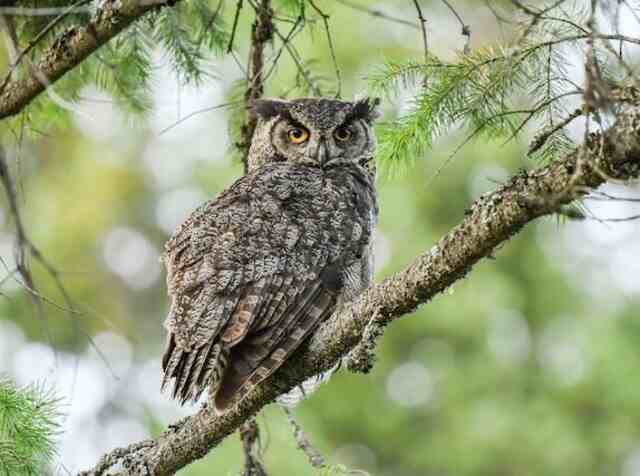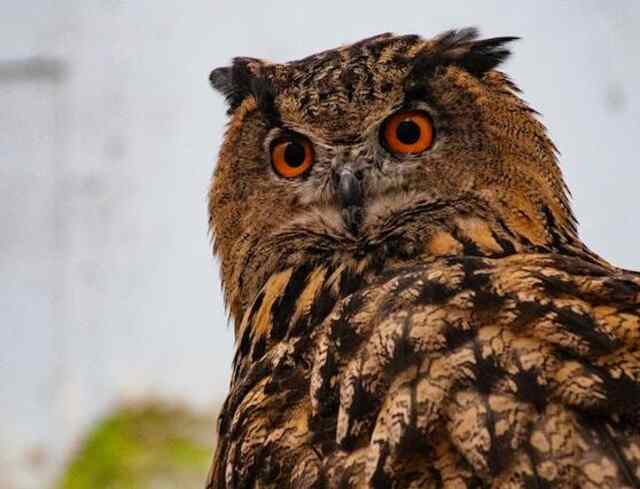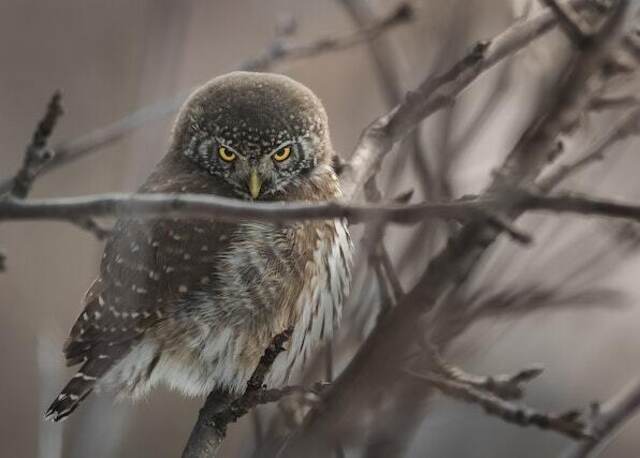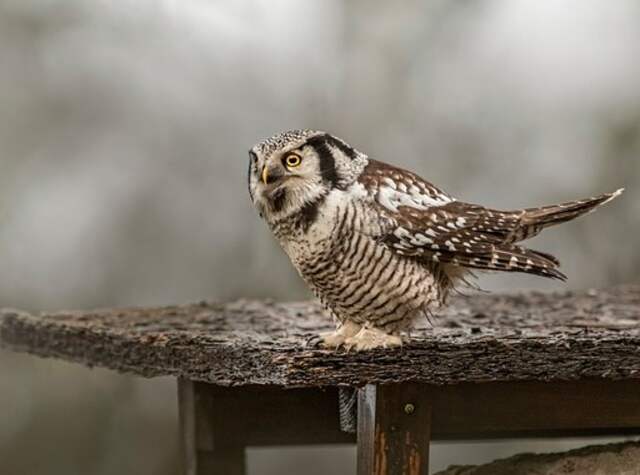Do owls eat grasshoppers? The answer is a resounding yes! But don’t let their hoots fool you, these majestic birds are more than just nocturnal predators.
In fact, their appetite for grasshoppers plays a crucial role in maintaining the balance of their ecosystem. If you’re curious about how owls interact with these hopping insects, keep reading to learn more!
Table of Contents
The Fascinating World of Owls and their Varied Diet
Owls have captivated our imaginations for centuries with their striking appearance and impressive hunting skills. However, have you ever wondered about their diverse palate?
From feasting on rodents and insects to indulging in fish and even other birds, owls are true culinary connoisseurs. Join us as we explore the fascinating world of owls and their ever-evolving diet.

Brief Overview of Owls and Their Diet
Owls are found on every continent except Antarctica and are part of the family Strigidae. There are around 200 species of owls, ranging in size from the tiny Elf Owl (which is only about 5 inches tall) to the massive Blakiston’s Fish Owl (which can weigh up to 10 pounds).
Despite their differences in size, all owls share certain physical characteristics that make them well-suited for hunting. As mentioned earlier, owls have a varied diet that depends on factors such as where they live, what time of year it is, and how much food is available in the area.
Some species primarily eat rodents such as mice and voles; others specialize in insects like beetles or moths; still others focus on fish or other birds. But one question that often comes up when discussing owl diets is whether they eat grasshoppers.
Do Owls Eat Grasshoppers?
The short answer is yes – some species of owls do eat grasshoppers. In fact, grasshoppers can be an important source of food for certain owl species, depending on where they live.
For example, the Great Horned Owl – one of the most widespread owl species in North America – has been known to eat grasshoppers along with a variety of other prey.
But why would an owl choose to eat grasshoppers? One reason is that they are abundant in many areas, so they can be a convenient and reliable food source. Additionally, grasshoppers provide a good source of protein and other nutrients for owls.
However, there are also potential dangers associated with eating grasshoppers – such as the possibility of ingesting harmful chemicals if the insects have been exposed to pesticides.
Overall, while grasshoppers may not be a primary food source for all owl species, they are certainly part of many owls’ diets.
As we’ll see in the following sections, owls have developed some unique hunting techniques to catch these agile insects – techniques that demonstrate just how fascinating and adaptable these birds really are.

Owls’ Diet
Owls are carnivorous birds and have a diverse diet that varies according to their species, habitat, and availability of prey. The majority of owls feed on small mammals such as rodents, rabbits, and shrews.
However, some species also eat insects, fish, amphibians, reptiles, and other birds. Despite the variety in their diet, all owl species depend on a balanced diet to maintain their health and meet their nutritional needs.
A varied diet ensures that they receive the required amount of proteins, fats, vitamins, and minerals essential for their growth and survival.
General information on what owls eat
Small rodents are the primary food source of most owl species. Owls have specially adapted talons that allow them to grip onto prey with great force without causing any damage to themselves. Owls also have sharp beaks that help them tear apart flesh.
Some owl species prefer different types of prey over others. For example, burrowing owls primarily hunt insects such as grasshoppers or beetles in addition to small mammals like mice or voles.
Owls’ nocturnal lifestyle means that they have evolved some unique adaptations for hunting in the dark. For instance, they can see incredibly well in low light conditions due to their enlarged eyes with more rod cells than cone cells, which help them detect motion better than color.
Importance of a varied diet for owls
Like most animals in nature; it is crucial for owls to receive a varied diet so that they can get all the required nutrients without over-relying on one type of food source while leaving another completely neglected.
A varied diet helps reduce the risk of nutrient deficiencies or excesses, which can lead to developmental disorders or health issues later in life.
For example; if an owl only eats small mammals like mice or voles, it might develop a vitamin E deficiency due to the absence of this nutrient in their diet. A varied diet plays an essential role in keeping owls healthy.
It helps them receive all the necessary nutrients that they need for survival and prevents them from developing health issues related to nutritional deficiencies or excesses.

Grasshoppers as Prey for Owls
Owls are known to be fierce predators, hunting and feeding on a variety of animals. One of the prey items that owls hunt is grasshoppers, which can make up a significant portion of some owl’s diet. While not all owls eat grasshoppers, those that do have developed specialized techniques for catching them.
Types of Owls that Eat Grasshoppers
There are several types of owls that feed on grasshoppers. The most common species include the barn owl, screech owl, and great horned owl. These owls have adapted to catch these speedy insects by using their sharp talons and strong beaks.
Benefits and Drawbacks of Grasshoppers as Prey
One benefit of eating grasshoppers is their high nutritional value. They are rich in protein and vitamins, providing owls with the energy they need to hunt and survive.
Additionally, since they are smaller than many other prey items like rodents or rabbits, it’s easier for the owl to digest them. However, there are also drawbacks to hunting grasshoppers.
One potential danger is that they can carry toxins from the plants they consume while living in the wild. If an owl eats too many toxic grasshoppers over a short period of time, it could become ill or even die.
Nutritional Value
Despite the potential dangers associated with consuming toxic grasshoppers, these insects still provide a great source of nutrition for owls. In addition to being high in protein and vitamins like thiamine and niacin, they also contain essential minerals like iron and zinc.
For young hatchlings who require more protein for growth than adult owls do, consuming large quantities of insects like grasshoppers can be especially beneficial as well. While not all owls eat grasshoppers, those that do have developed specialized hunting techniques to catch them.
The benefits of grasshoppers as prey include their high nutritional value, but there are also potential dangers associated with consuming toxic insects.
As always, it’s important to understand the dietary habits of these fascinating predators in order to appreciate and preserve their role in the ecosystem.
| Nutrient | Amount per 100 grams of grasshoppers |
|---|---|
| Protein | 20-25 grams |
| Fat | 5-10 grams |
| Fiber | 3-6 grams |
| Calcium | 30-50 milligrams |
| Iron | 3-5 milligrams |
| Magnesium | 30-50 milligrams |
| Phosphorus | 120-150 milligrams |
| Potassium | 300-400 milligrams |
| Zinc | 3-5 milligrams |
| Vitamin A | 100-150 micrograms |
| Vitamin B2 | 0.2-0.3 milligrams |
| Vitamin B6 | 0.1-0.2 milligrams |
| Vitamin B12 | 0.1-0.5 micrograms |
Keep in mind that the nutritional value of grasshoppers may vary depending on the species and other factors such as diet and habitat.

Hunting Techniques Used by Owls to Catch Grasshoppers
Overview of Owl Hunting Behavior
Owls are known for their silent, stealthy hunting style. They are able to swoop down on their prey without making a sound, thanks to their special wings that allow them to fly silently.
Owls also have excellent night vision, which makes it easier for them to hunt in the dark. When it comes to hunting grasshoppers, owls use a combination of stalking and ambushing techniques.
They will often perch on a branch or tree trunk and wait for the grasshoppers to come out into the open. When they spot one, they will silently glide down and snatch it up with their sharp talons.
Specific Techniques Used to Catch Grasshoppers
Stalking is one technique that owls use when hunting grasshoppers. They will move slowly and purposefully through the vegetation, carefully scanning the ground for any signs of movement.
Once they spot a grasshopper, they will freeze in place and wait until it moves again before striking quickly. Another technique used by owls is ambushing.
Owls like to perch on tree branches or other high points where they can keep an eye on the surrounding area. When a grasshopper comes into view, the owl will pounce down from its perch with lightning-fast speed.
In addition to these techniques, some owls have been known to chase after grasshoppers in mid-air. This requires incredible agility and reflexes on the part of both the owl and the grasshopper.
The Art of Owl Hunting
Overall, owls are highly skilled hunters that use a variety of techniques when catching prey like grasshoppers. Their silent flight and excellent night vision make them incredibly effective at stalking their prey without being detected.
And when the time is right, they can strike with incredible speed and accuracy. Watching an owl hunt is truly a sight to behold, and it’s a testament to the incredible beauty and complexity of nature.

Conclusion
Summary of Key Points About Owls and Their Diet, Including the Role of Grasshoppers
Owls are fascinating creatures that have specific dietary habits. They generally eat small rodents, insects, and other small animals. However, some species of owls such as the burrowing owl and the great horned owl also eat grasshoppers as part of their diet.
Grasshoppers are a good source of protein and nutrients for these birds. While grasshoppers are beneficial to some species of owls, it’s important to note that not all species can digest them easily.
In fact, some species can suffer from digestive issues if they eat too many grasshoppers or consume them too frequently in their diet. Understanding what types of food owls eat is essential for conservationists who study these remarkable birds.
Final Thoughts on the Importance of Understanding Owl’s Dietary Habits
By understanding the dietary habits of owls, we can help protect their habitat and ensure that they have access to the food they need to thrive. Conservationists can work to preserve natural habitats where owls live, which will provide them with a variety of prey options, including grasshoppers.
In addition to protecting habitats, we can also work towards reducing pesticide use in areas where owls live. Pesticides can harm both prey populations and directly affect owl health when they consume contaminated prey.
Overall, understanding owl dietary habits is crucial for conservation efforts aimed at preserving these magnificent birds for future generations to enjoy.
By taking steps now to protect these creatures and their habitats, we can ensure that the sound of an owl hooting continues to echo through our forests and countryside long into the future.
FAQs: Do Owls eat Grasshoppers
What other animals do owls eat besides grasshoppers?
Owls have a diverse diet that includes rodents, birds, insects, fish, and more. Owls are versatile hunters and will devour almost any prey they can seize.
Why do owls eat grasshoppers?
Grasshoppers are a nutritious food source for owls and play an important role in their ecosystem. They are high in protein and other essential nutrients that help owls survive and thrive.
Do all species of owls eat grasshoppers?
No, not all species of owls eat grasshoppers. Some prefer larger prey while others may consume more insects. However, grasshoppers are a common food source for many species of owls.
How do owls catch grasshoppers?
Owls use their sharp talons and beaks to catch and kill grasshoppers. They typically hunt at night and use their exceptional hearing and vision to locate their prey.
Can grasshoppers be harmful to owls?
While grasshoppers are a staple in many owl diets, they can also carry parasites and diseases. However, this is not a significant concern, as owls have a highly efficient digestive system that helps them eliminate harmful bacteria and toxins.



